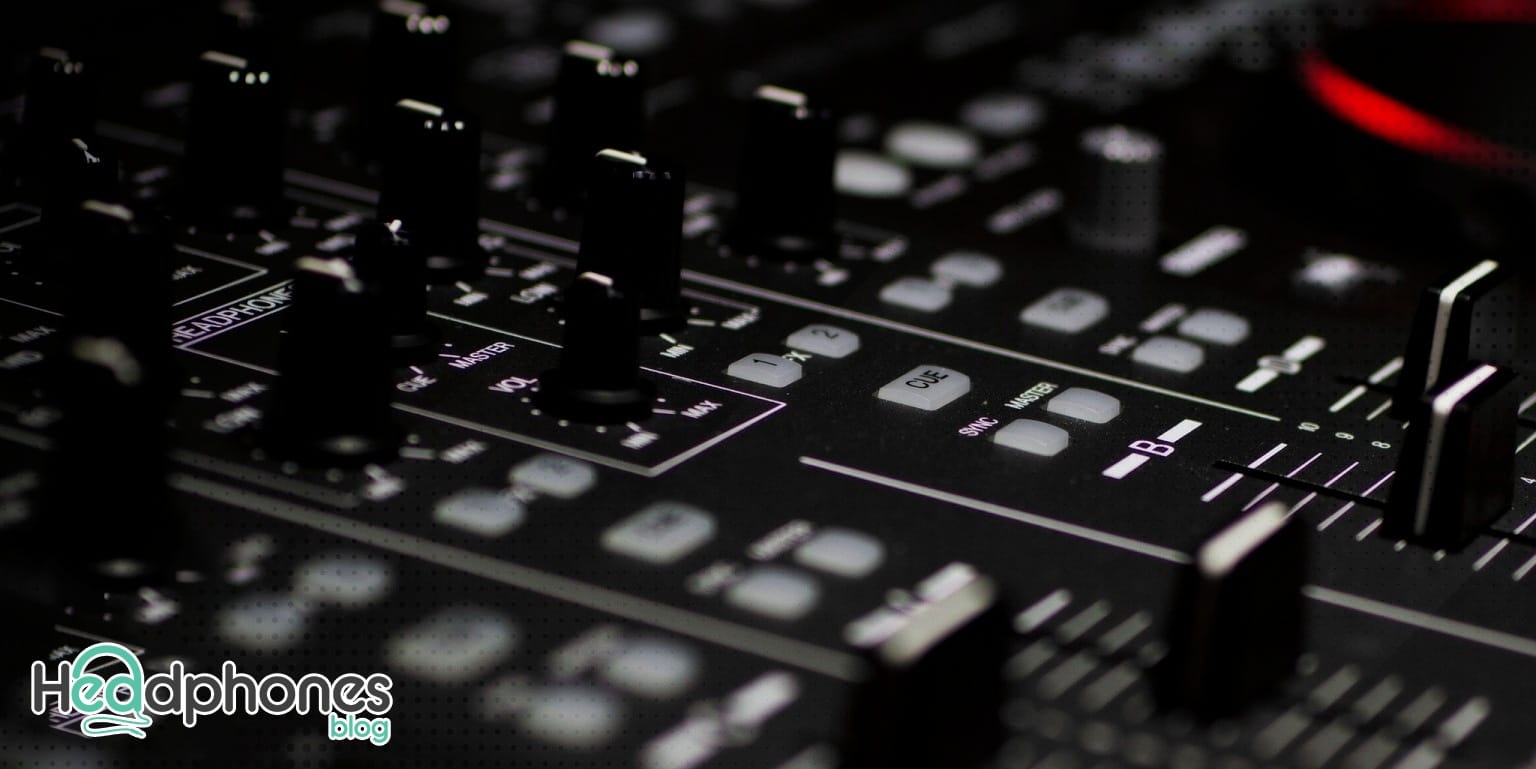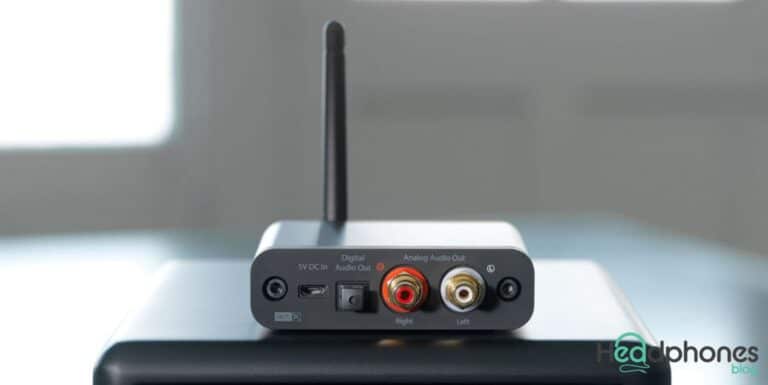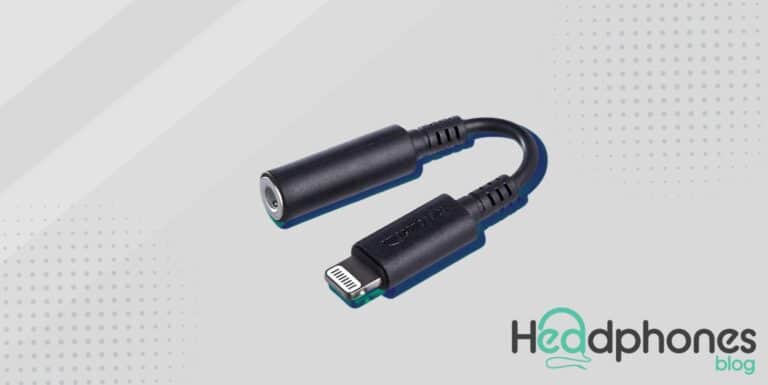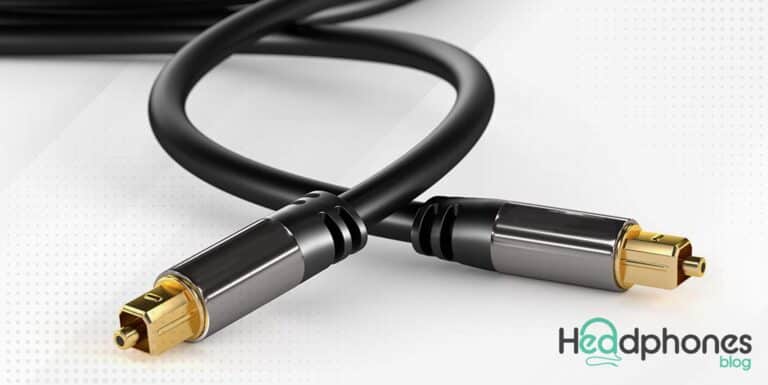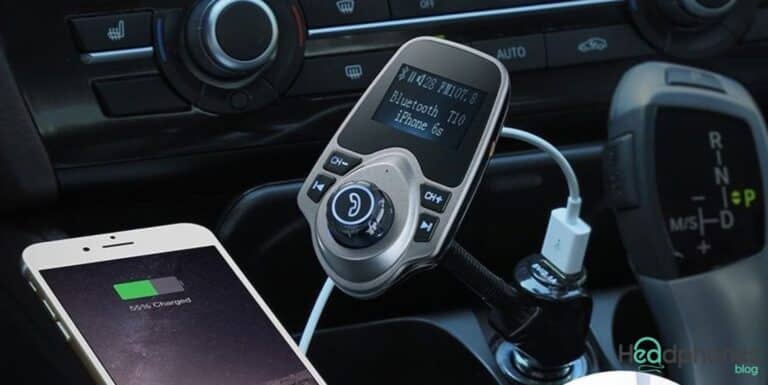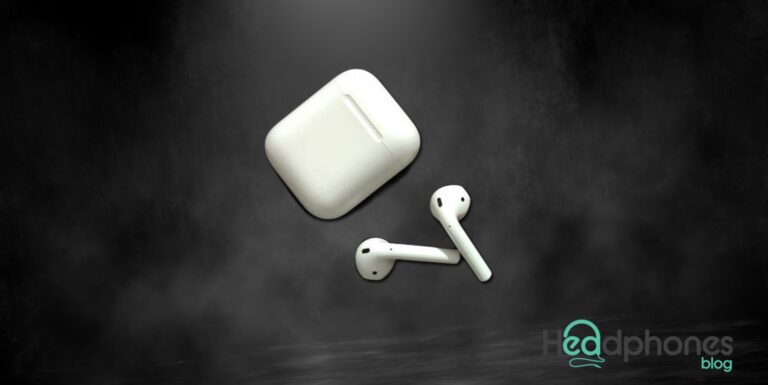Top 10 Best Audio Mixers & Ultimate Buying Guide In 2022
Whether you’re performing live or recording, the best audio mixer is one of the most important pieces of equipment you can buy. This ultimate guide will give you some details about the best audio mixers. Continue reading to learn more!
How can you produce a single, cohesive best audio mixers signature when you need to amplify the sound of various instruments? Every artist requires good audio mixers to ensure their performances sound clear and balanced. An mixers for music is one of the most important pieces of equipment you can buy, whether you’re performing live or recording.
Do you know what kind of mixers for music you should get? Depending on your budget and requirements, it is either a $100 or $1,000 question. Sound mixers are available at various price tiers for both enthusiasts and professionals. Although they all offer a variety of instruments and sound sources, depending on your needs, you may find one or more of them to be more advantageous than the others.
A shopping list is useful when deciding what you need. It is where we step in. This audio mixer buying guide and review results from many hours of research to help you save time and money on your next mixer.
If you’re looking for a new mixer for music or replacing an old one, our buyer’s guide will show you which essential features can be skipped. Continue reading to discover more about audio mixers and how they can assist you in producing better-sounding audio productions.
What Is the Purpose of an Audio Mixer?
A centralized source is often required to govern volume levels and effects when multiple instruments are connected and amplified. Otherwise, certain instruments would be louder than others, throwing off the entire group.
An audio mixer’s principal function is to receive, combine, process, and monitor sounds. An mixers for music links and manages all electrically powered instruments and microphones in a recording session. You can modify the overall balance of distinct sounds by using the various volume and effect options. For example, one of their better features is the ability to replace audio mixers on the fly.
What Are the Different Types of Audio Mixers?
The field of audio mixing is extensive and exciting. Musicians of the highest caliber are constantly looking for the latest and finest audio mixers. A sound mixer should be able to handle everything from live concerts to television sets and recording studios in terms of audio quality.
On the market today live sound mixers for music in various formats. However, analog, digital, and powered audio mixers are the most prevalent. Each has advantages and disadvantages. This section will teach you how to select the optimal mixer for your application.
Mixers Digital
Digital mixers offer a broader variety of control possibilities. For example, setup can be pre-programmed, saved, and retrieved, which is useful if you regularly perform with the same band. It’s also useful if you need to make a last-minute setup change during the event.
Most digital mixers include a wireless connection, allowing remote control via an iPad or smartphone. It suggests that you do not need to remain stationary at all times. For example, you may move around the room while mixing music or recording a stereo mix on your phone or tablet, ensuring that the audience hears music from all directions.
Each channel in many digital mixers features additional inbuilt sound effects. You do not need extra mixers for music equipment for richer sound effects and complex signal processing functions.
On the other hand, making changes in a digital mixer may be challenging if you are unfamiliar with it because you must first browse through several menu options on the touchscreen before making any changes to a single channel. If you want to make multiple changes simultaneously, you must pre-program them for faster access.
Line Mixers and Summing
Line mixers, as the name implies, are in charge of signal mixing at the line level. However, they almost invariably feature an analog architecture and are rather simple, with single volume control for each channel. When utilized in live situations, it can l too many players to deliver music between sets while clearing channels on the main mixer.
Summing mixers for music are primarily analog in design and can be used in studios to condense and fine-tune final mixes. They add warmth to the output of final digital mixes that some engineers consider frigid. For example, you can replicate the analog-like warmth generally associated with older recording systems utilizing tube technology, which can find in some high-end summing mixers.
Analog Mixers
When thinking of a mixing desk, most people imagine a typical analog mixer. It has a standard design and a fairly unified structure, so anyone who knows how to operate a mixing desk can pick one up and start using it immediately.
Analog electronics control analog mixers. Each function has its control, all visible and accessible via the control panel.
Most people imagine typical analog mixers for music when they think of a mixing desk. It has a standard design and a fairly unified structure, so anyone who knows how to operate a mixing desk can pick one up and start using it immediately.
These mixing consoles come in a variety of sizes, from almost pocketable to those fit for professional use.
In general, analog mixers for music are less expensive than digital mixers. However, they lack the type of automation that sophisticated settings may require. They also lack wireless remote control, requiring continual attendance at the board.
In addition, analog mixers feature fewer built-in sound effects than digital mixers. As a result, if you want advanced audio effects and sound processing systems, you’ll need to buy separate equipment.
Mixers with Power
Powered mixers are a subset of audio mixers. A powered mixer is an analog mixer that includes power amplifiers. Most powered mixers feature two amplifier channels and can simultaneously connect two speakers, one speaker, and one monitor.
They are often easy to set up and run and portable.
Line-level outputs on powered mixers make connecting additional powered speakers and monitor simple.
Top 10 Best Audio Mixers In 2022
If you want to make the best music possible, you must have access to the most talented engineers and mixers. Whether you’re mixing digitally or live, you’ll need the correct mixer in your control room.
We’ve put up a list of the top ten audio mixers for 2022. You can use this advice to select the best audio mixers for your needs, whether you’re recording for a large or small concert or simply for your personal music collection.
Here are the top 10 best audio mixers in 2022:
- Soundcraft EPM12 High-Performance 12-Channel Audio Mixer (Overall Best Audio Mixers)
- Pyle Professional Audio Mixer Sound Board Console PMXU63BT (Best Audio Mixers for Professional Use)
- TC Helicon GoXLR Revolutionary Online Broadcaster Platform with 4-Channel Mixer (Best Audio Mixer for Online Streamers)
- Tascam Miscast 4 Podcast Studio Mixer Station with built-in Recorder / USB Audio Interface (Best Audio Mixers for Podcasting)
- Zoom LiveTrak L-12 Digital Mixer & Multitrack Recorder (Best Audio Mixers for Live Performances)
- PreSonus StudioLive AR12c 14-Channel USB-C Hybrid Digital/Analog Performance Mixer (Best Audio Mixers for Home Studio)
- StudioLive 16.0.2 USB 16×2 Performance & Recording Digital Mixer (Best Digital Audio Mixers)
- Behringer XENYX X1222USB (Best Compact Audio Mixers)
- YAMAHA MG10XU 10-Input Stereo Mixer with Effects (Best Analog Audio Mixer)
1. Soundcraft EPM12 High-Performance 12-Channel Audio Mixer (Overall Best Audio Mixer)
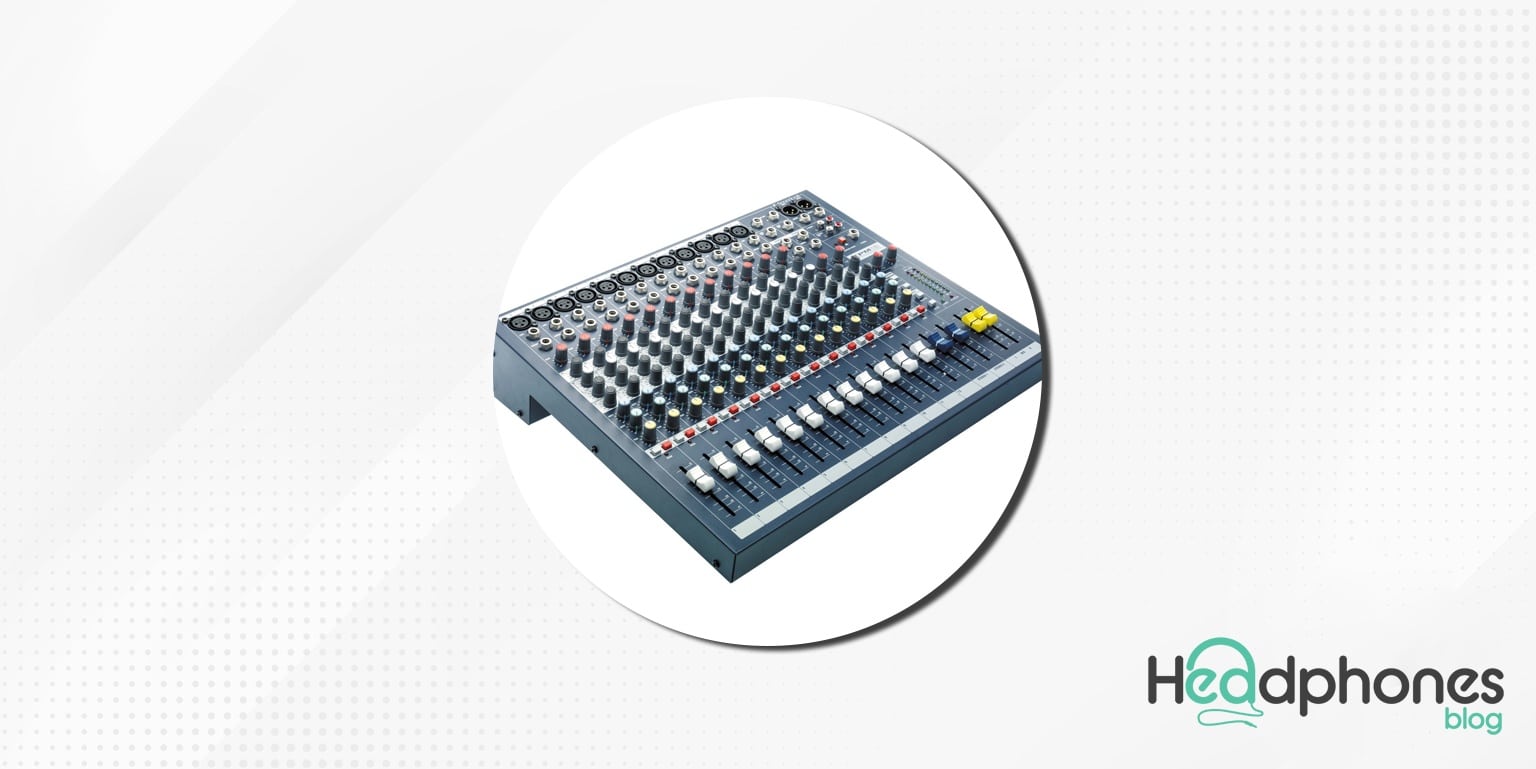
PRODUCT DESCRIPTION:
The Soundcraft EPM12 High-Performance 12-Channel Best Audio Mixers is a fantastic alternative if you need a simple mixer. It’s a well-made piece of equipment that accomplishes its job well. It is a fantastic choice for individuals who like to apply external effects. The Soundcraft EPM12 is the greatest audio mixer on our list right now.
When we first saw the Soundcraft EPM 12, we thought it was a well-designed, tiny workstation with a high-quality look. In our testing, we discovered that the sound is quite easy to shape, and the EQ knobs are gentle and ‘linear’ enough to allow for fine-tuning in each scenario where we used this desk.
Judged the control to be fluid and accurate by our specialists. The ability to sweep the mids is a significant advantage. We used XLR cables to connect the speakers, delivering a pure, transparent sound with plenty of headroom. Even with less expensive mics, the vocals were crystal clear.
A big advantage is the built-in power source. Despite the extra weight, you won’t have to deal with the tinier connectors and separate transformers on the mixer that other brands demand.
ALL ABOUT THIS PRODUCT
- Two configurable auxiliary buses.
- XLR-type and ¼” metal jack connector sockets.
- RCA phono stereo playback inputs and record outputs.
- 3-band EQ with a swept mid on mono inputs.
- RS inserts sockets and inserts on all mono inputs and mix output.
- Intuitive and comprehensive solo system
PROS AND CONS
Here are some of the pros and cons of this product:
PROS
- Excellent build quality
- Great sound
- Intuitive and comprehensive solo system.
CONS
- We did not experience any issues with this audio mixer.
SPECIFICATION
| Brand | Soundcraft |
| Number of Channels | 12 |
| Item Dimensions | 14.25 x 17 x 3.56 inches |
| Item Weight | 14.77 pounds |
| Connectivity Technology | Auxiliary |
2. Pyle Professional Audio Mixer Sound Board Console PMXU63BT (Best Audio Mixer for Professional Use)
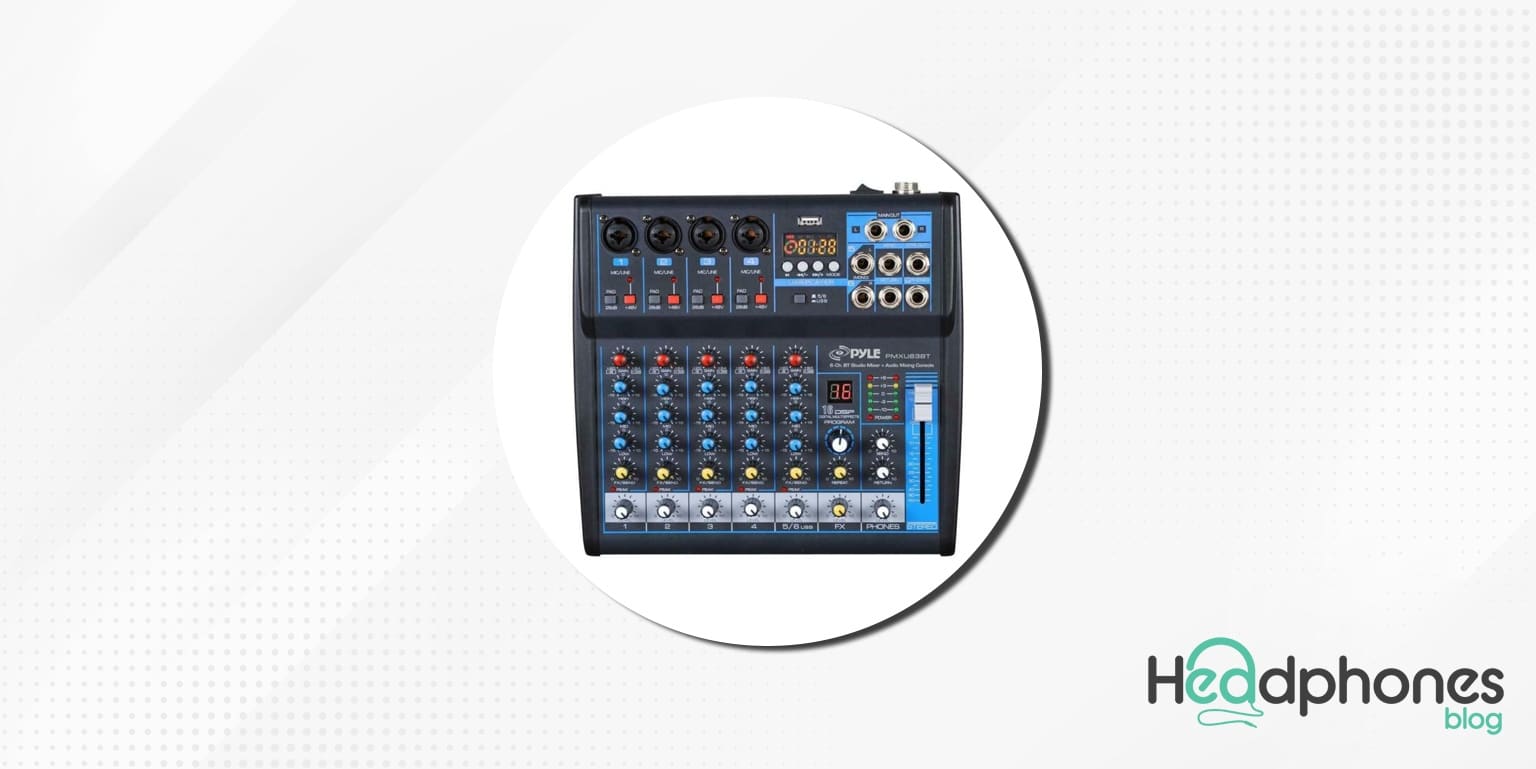
PRODUCT DESCRIPTION:
The Soundcraft EPM12 High-Performance 12-Channel Best Audio Mixers is a fantastic alternative if you need a simple mixer. It’s a well-made piece of equipment that accomplishes its job well. It is a fantastic choice for individuals who like to apply external effects. The Soundcraft EPM12 is the greatest audio mixer on our list right now.
When we first saw the Soundcraft EPM 12, we thought it was a well-designed, tiny workstation with a high-quality look. In our testing, we discovered that the sound is quite easy to shape, and the EQ knobs are gentle and ‘linear’ enough to allow for fine-tuning in each scenario where we used this desk.
Judged the control to be fluid and accurate by our specialists. The ability to sweep the mids is a significant advantage. We used XLR cables to connect the speakers, delivering a pure, transparent sound with plenty of headroom. Even with less expensive mics, the vocals were crystal clear.
A big advantage is the built-in power source. Despite the extra weight, you won’t have to deal with the tinier connectors and separate transformers on the mixer that other brands demand.
ALL ABOUT THIS PRODUCT
- Mic and stereo line inputs: Supports XLR and unbalanced 1/4″ Plugs, a 48V Phantom button, a very accurate LED Peak Level Indicator, and an ultra-musical 3-band EQ on all channels.
- Rugged steel chassis: With sealed rotary controls to withstand dust and grime, this small DJ Mixer will provide total dynamic control, making it ideal for high-quality on-stage performances, live gigs, and Karaoke.
- NEW MULTI-VOLTAGE POWER SUPPLY – 100V-240V (plus/minus 15V DC power adaptor) suited for worldwide use; enjoy a value-packed mixing solution today with consistent performance.
- USB/FLASH READER/MP3 COMPATIBILITY: To mix and record, connect your external USB, computer PC, flash drive, or Bluetooth device. To play/pause, skip tracks, and switch between modes, utilize the built-in controls.
- BLUETOOTH WIRELESS STREAMING – Stream audio wirelessly to the console unit without a cable. This mixers for music can wirelessly stream music from an iPad, iPhone, or Android smartphone to a Pandora or Spotify mixing board.
PROS AND CONS
Here are some of the pros and cons of this product:
PROS
- It has a built-in soundboard for mixing and recording audio recordings.
- You can stream music from your phone using Bluetooth.
- There is also a microphone and a stereo line-in.
- Versatile; suitable for high-quality on-stage performances, live gigs, and Karaoke.
- Simple to use.
CONS
- We did not experience any issues with this audio mixer.
SPECIFICATION
| Brand | Pyle |
| Numbers of Channels | 6 |
| Item Dimensions | 2.26 x 9.69 x 9.26 inches |
| Item Weight | 3.75 Pounds |
| Connectivity Technology | Interface, Xlr, Usb, Bluetooth |

3. TC Helicon GoXLR Revolutionary Online Broadcaster Platform with 4-Channel Mixer (Best Audio Mixer for Online Streamers)
PRODUCT DESCRIPTION:
The TC Helicon GoXLR Revolutionary Online Broadcaster Platform with 4-Channel Best Audio Mixers is a streamer-specific audio mixer. It features a wide selection of functions to pick from and is simple to use. You can even sample sounds and tweak them to your liking. You can amuse your audience with all of the available voice effects. However, it deserves to be ranked as the finest audio mixer for online streamers on our list.
In terms of design, GoXLR is a little black device with various features concentrated on sound quality and control. It has a downward-slanted construction similar to a keyboard.
Because of the downward slope, you can reach the various buttons and turn on the device more rapidly. It also has RGB lights that can customize via software. This four-channel mixer includes four volume sliders as well as a mute button. You can also use them to swiftly alter audio during streaming sessions.
We had no problems speaking or listening to music while running our tests. Instead, we could quickly adjust the volume and effects throughout our gaming sessions. We also played around with microphone sound effects and had a great time. As an easy-to-use audio mixing device, it made things a lot less complicated for us.
ALL ABOUT THIS PRODUCT
- 4-channel USB Mixer/Audio Interface with Motorized Faders.
- Dedicated FX and Sampler Sections.
- LCD Scribble Strips.
PROS AND CONS
Here are some of the pros and cons of this product:
PROS
- There are numerous customizing possibilities available.
- Professionals will appreciate these vocal effects.
- Increases your control over music, chat, microphone, and sounds.
- Audio routing is extensive for online streams.
CONS
- We encountered a few error messages during the initial setup, but otherwise, we had no problems with this device.
SPECIFICATIONS
| Brand | TC-Helicon |
| Item Weight | 3.53 pounds |
| Item Dimension | 6.5 x 11 x 2.75 inches |
| Output Wattage | 10 watts |
| Item Model Number | GOXLR |
4. Tascam Mixcast 4 Podcast Studio Mixer Station with built-in Recorder / USB Audio Interface (Best Audio Mixer for Podcasting)
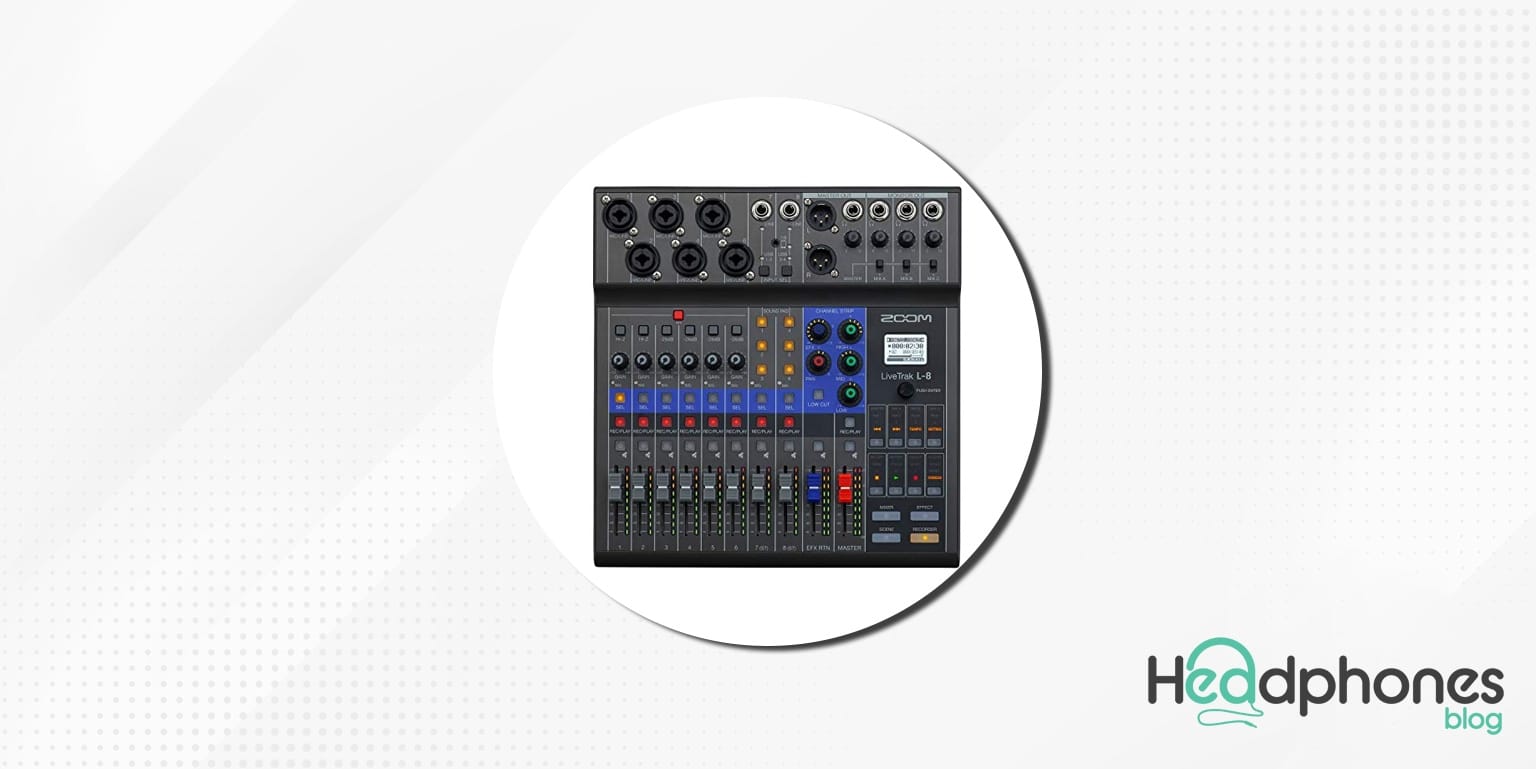
PRODUCT DESCRIPTION:
Tascam Miscast 4 Podcast Studio Mixer Station with Built-in Recorder / USB Audio Interface is a multitrack recorder with different mixers for music inputs and outputs that connects through USB. Tascam’s Podcast Editor software allows you to balance and record your podcast’s audio in either stereo or multitrack format, then transmit via USB to a variety of platforms (Mac, PC, and iOS, with Android coming soon), edit, and export (WAV, MP3, MP4). What more could we want? On our list, it is our pick for the best audio mixer for podcasting!
In terms of specifics, the Miscast 4 has many physical knobs and faders, a touchscreen with menus, and eight trigger pads for activating audio and effects. The interface’s heart is a dazzling five-inch touch screen. May use it alone; despite its size, it can fit inside a backpack.
Certain functions, such as importing sound files into pads, necessitate the software editor’s usage. Because of its eight-colored pads, we initially mistook Miscast 4 for a drum machine. Those pads, similar to a drum machine, activate eight different sound effects. Miscast 4 includes applause, a drum loop, censor “bleep,” and a couple more pad noises.
On microphone 1, the final pad will additionally trigger audio effects such as pitch shift and reverb. A single fader controls the volume of all the pads, but there is no way to adjust the relative loudness of individual pads, which we found peculiar.
ALL ABOUT THIS PRODUCT
- Podcast mixer for up to four persons, including four mic inputs and four headphone outputs.
- Invite guests and friends: Using Bluetooth, USB input, or a 4-pole TRRS audio cable, Mix-Minus can connect call-ins with echo-free audio.
- The 5-inch touch touchscreen provides straightforward operation.
- It is fully compatible with the proprietary TASCAM Podcast Editor software to cover the whole production workflow.
PROS AND CONS
Here are some of the pros and cons of this product:
PROS
- Compact and durable.
- Operation modes include multitrack and stereo.
- Software for editing podcasts is available.
- The talkback mic is well-integrated.
CONS
- Certain features are only available through the Podcast Editor.
SPECIFICATION
| Brand | Tascam |
| Compatible Devices | Personal Computer |
| Supported Software | TASCAM Podcast Editor |
| Connectivity Technology | USB |
| Number of Channel | 14 |
5. Zoom LiveTrak L-12 Digital Mixer & Multitrack Recorder (Best Audio Mixer for Live Performances)
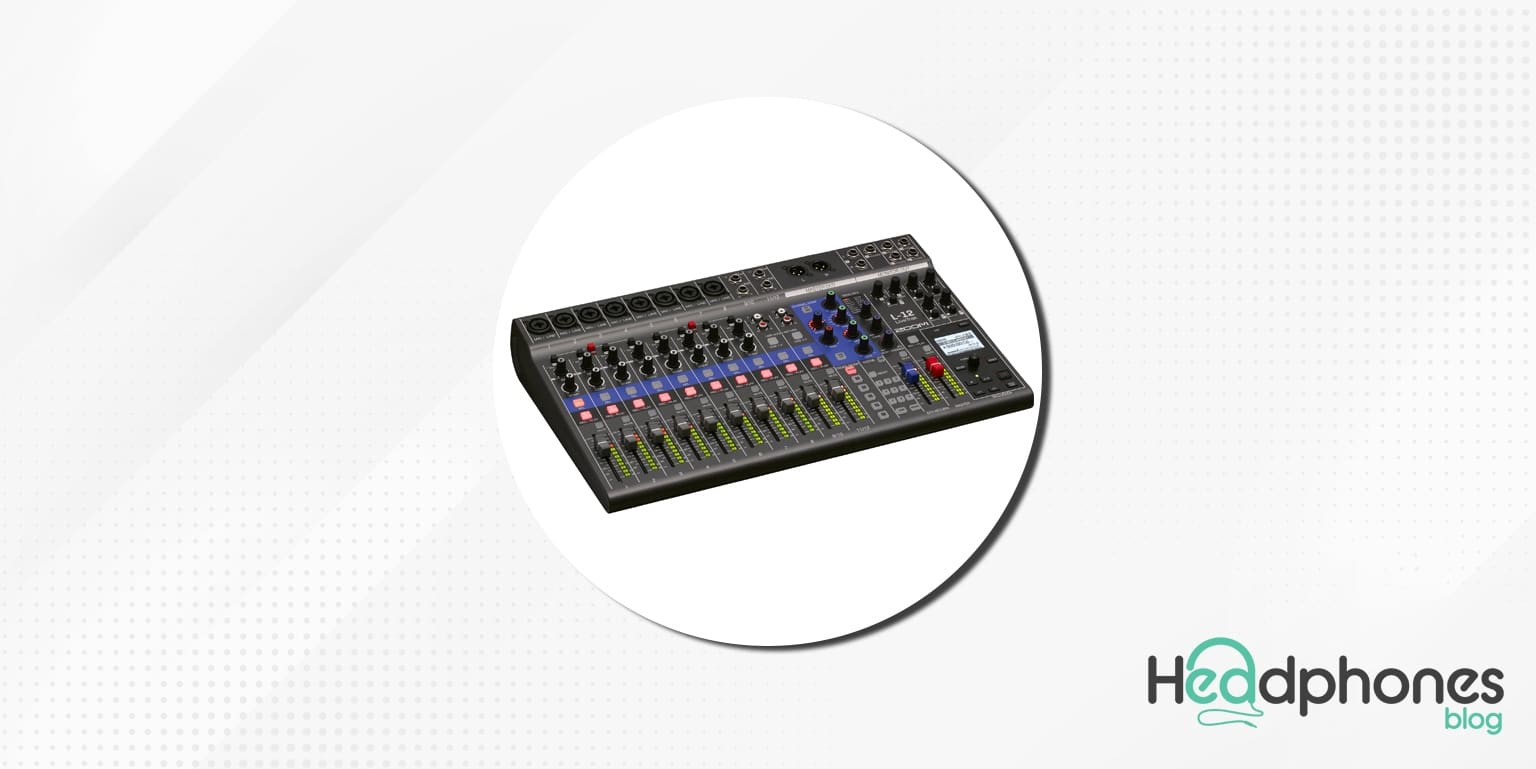
PRODUCT DESCRIPTION:
The Zoom LiveTrak L-12 digital mixers for music simplify the recording and mixing of live performances and demos! You get to do everything in a simpler and faster manner! It contains 14 inputs and 4 outputs, so you’ll have plenty of space to monitor audio! You can create and edit savable mixes for up to 5 band members!
It also includes a built-in slate microphone for recording comments or talkbacks throughout the recording process! We couldn’t possibly cover every detail regarding the digital mixer! So, what exactly does it all mean? We like it, and we’re sure you will as well!
On the LiveTrak, the 12-segment meters are situated alongside the faders rather than above them. The mixing feature of the LiveTrak contains a simple but powerful scene-based recall mechanism that does more than just display signal levels. Each LiveTrak Project can save up to nine situations, which are saved and accessed via a numbered button grid.
For its intended applications, the LiveTrak features a well-balanced design. It’s a wonderful tool for bands and small concerts, a multitrack recorder in the practice room, and a USB audio interface in the studio. It has enough I/O to record a full drum kit and a few other instruments, and it’s as simple to operate as any digital mixer or multitracker.
ALL ABOUT THIS PRODUCT
- 12 distinct channels (8 mono and 2 stereos) with XLR or 1/4-inch connectors.
- 44.1 kHz: -1.0 dB: 20 Hz – 20 kHz,96 kHz: -3.0 dB: 20 Hz – 40 kHz. 14-track Simultaneous recording, 12-track playback
- 5 powered headphone outputs, each with a mix that can be customized and saved.
- Scene saving function; up to 9 scenes can be saved at once.
PROS AND CONS
Here are some of the pros and cons of this product:
PROS
- All-in-one digital mixer, multitrack recorder, and USB audio interface.
- Each cue mix has a separate headphone output.
- Combining user-friendly and simple functionality with scene recall and accurate metering.
- Allows recording to its internal SD card and a computer linked to it simultaneously.
CONS
- No solo function or reversal of polarity.
- Cue mixes do not include onboard reverb/delay.
- The master output level is difficult to control.
SPECIFICATION
| Brand | Zoom |
| Item Weight | 5.65 pounds |
| Number of Pieces | 1 |
| Item Length | 17.5 inches |
6. PreSonus StudioLive AR12c 14-Channel USB-C Hybrid Digital/Analog Performance Mixer (Best Audio Mixer for Home Studio)
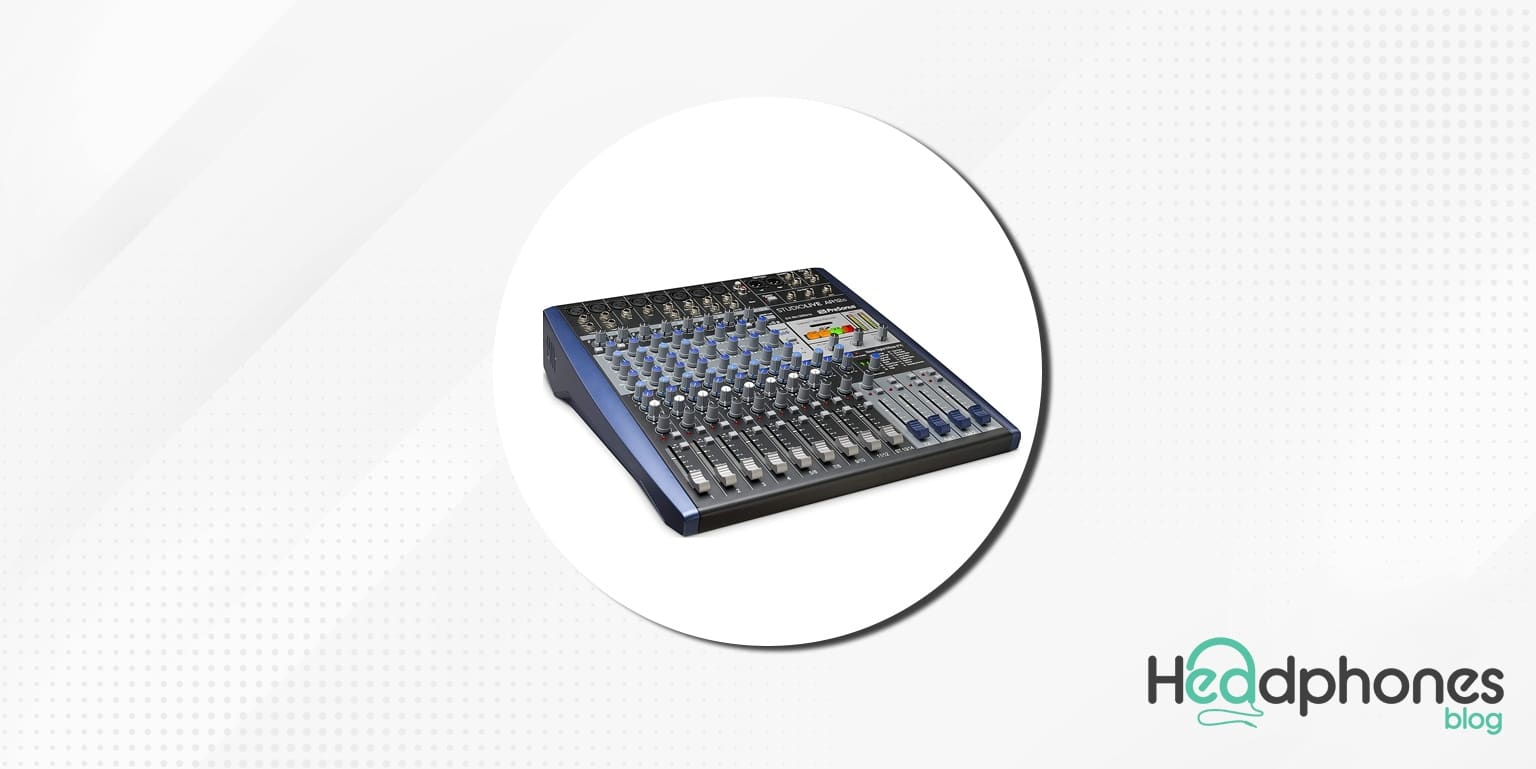
PRODUCT DESCRIPTION:
The PreSonus StudioLive AR12c 14-Channel USB-C Hybrid Digital/Analog Performance Mixer is a small, stylish device that will complement any home-built Livestreaming system. The well-placed buttons are easy to use, and the sliders (albeit a little plasticky) feel smooth and have enough movement to allow for small changes.
It features a USB port for DAW transmission to Livestream devices, which is a wonderful feature, and we have included it on our list of the best audio mixer for a home studio.
Another great feature is the built-in digital SD card recorder. Customers who want the mixers for music of their speeches captured so they can acquire it on CD or in another format after the event are not required to hire a second sound engineer. You can complete this process by utilizing a digital SD card. It’s fantastic!
During testing, we discovered that the availability of Bluetooth input is a fantastic feature. It’s fantastic to wirelessly broadcast conference background music from our iPhone and iPad without adding additional input. For the occasional stage singer, reverb is a wonderful addition to the superb addition of FX generator. Just make sure you don’t over-pod the sound source.
ALL ABOUT THIS PRODUCT
- USB 2, 14×4 24-bit/96 kHz 0 audio recording interface (through USB-C connection); record every channel as well as the main mix
- 2×2 SD recorder (main record mix); SD and SDHC formats up to 32 GB supported.
- Eight balanced microphone inputs with XMAX mic preamps plus two instrument inputs, 12 balanced line level inputs, 2 insert points, Stereo Super Channel (Ch. 13/14), and Bluetooth 5 are all included.
- The recording package includes Capture live-recording software and Studio One Artist DAW for Mac and Windows.
PROS AND CONS
Here are some of the pros and cons of this product:
PROS
- Reliable Bluetooth connectivity.
- Has a smooth and reassuringly professional feel.
- The preamps are warm and musical.
CONS
- We did not experience any issues with this audio mixer.
SPECIFICATION
| Brand | PreSonus |
| Number of Channels | 14 |
| Item Dimensions | 15 x 16 x 3.7 inches |
| Item Weight | 6.5 kilograms |
| Connectivity Technology | Interface |
7. StudioLive 16.0.2 USB 16×2 Performance & Recording Digital Mixer (Best Digital Audio Mixer)
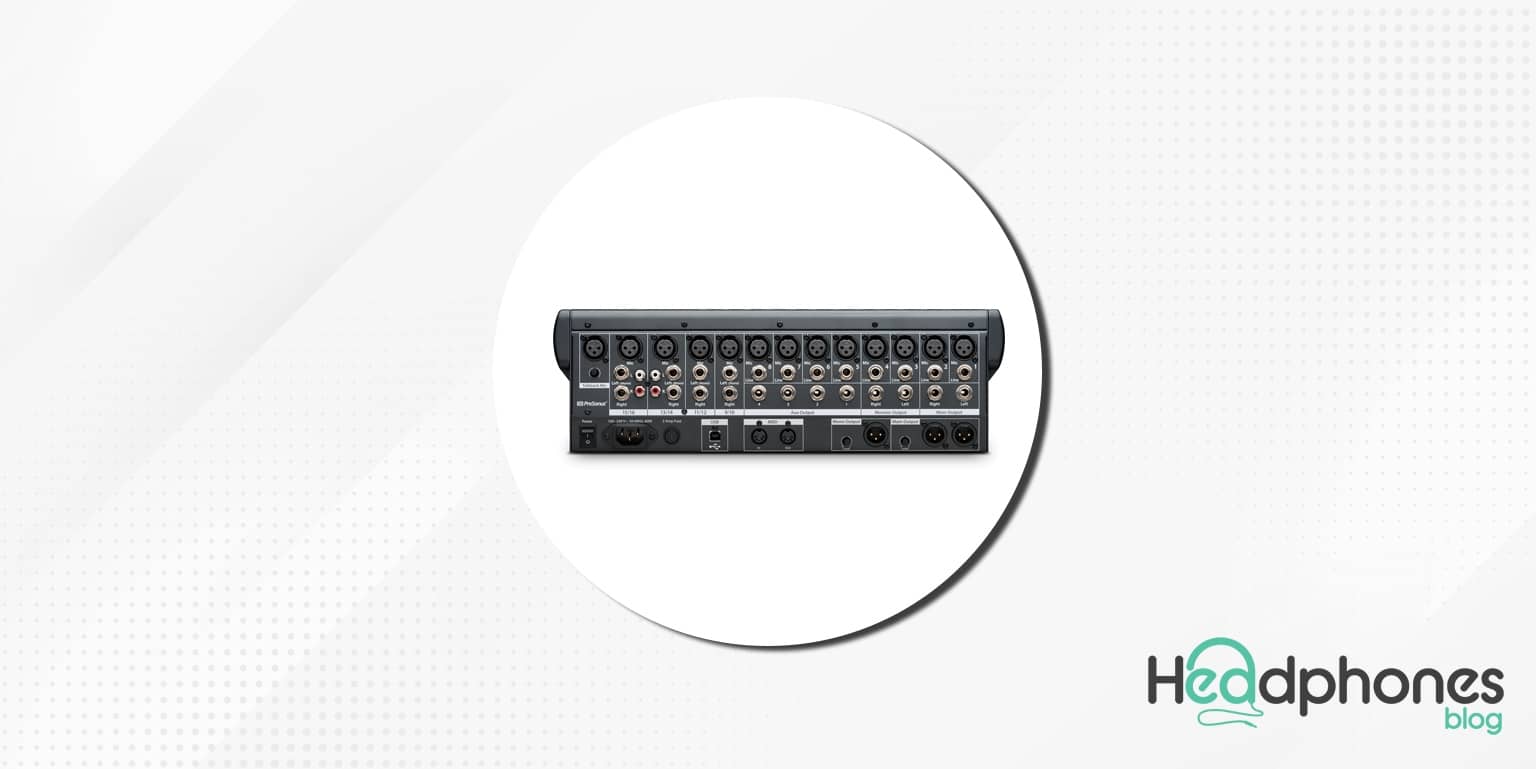
PRODUCT DESCRIPTION:
A digital mixer for music with wireless iPad control, 16 built-in audio interfaces, and enough effects and processing to handle numerous gigs or studio sessions, such as the StudioLive 16.0.2 USB 162 Performance & Recording Digital Mixer is excellent. It’s a remarkable accomplishment at this price; thus, we chose it as the finest digital audio mixer on our list.
16.0.2 has a small footprint of less than two square feet, but it has a substantial feel. Everything has a solid feel; the faders may have some lateral movement, but they are still superior to most other devices of this size.
This small piece of gear has a big-console feel and sound thanks to Fat Channel features. It’s incredible to have so much power in such a small container. The variable high-pass filter has a broad range, and the fact that it is on such a small board makes it appear much larger!
The sound of the EQ amazed us. Unlike many analog mixers of this size, the highs are sharp and delicate, while the lows are deep and defined, with no audible phase shift. We played around with quickly sweeping the mid-frequency. We didn’t detect jitters or aliasing, which appeared to be quite fast and responsive. All of the features sounded and felt just as we expected.
ALL ABOUT THIS PRODUCT
- 16 channel inputs (8 mono and 4 stereos) with 60 mm faders (12 faders)
- 12 XMAX solid-state Class A mic preamplifiers (12 channels + talkback)
- There are four auxiliary buses (pre/post-fader send) and two internal FX buses.
- All channels and buses have Fat Channel signal processing, which includes a 3-band semi-parametric EQ, compressor, downward expander, and limiter.
- All channels and the main L/R mix are recorded using an 18-in/16-out USB 2.0 audio interface (24-bit/44.1 kHz and 48 kHz).
PROS AND CONS
Here are some of the pros and cons of this product:
PROS
- The layout and design are carefully thought out.
- The audio playback quality of live music flowing into the board via the software is perfect.
- Studio One program is included.
- Capability for remote control.
CONS
- The fader action became slightly stuck.
SPECIFICATION
| Brand | PreSonus |
| Number of Channels | 16 |
| Item Dimension | 15.56 x 16 x 5.5 inches |
| Item Weight | 20 pounds |
| Connectivity Technology | USB |
8. Behringer XENYX X1222USB (Best Compact Audio Mixer)
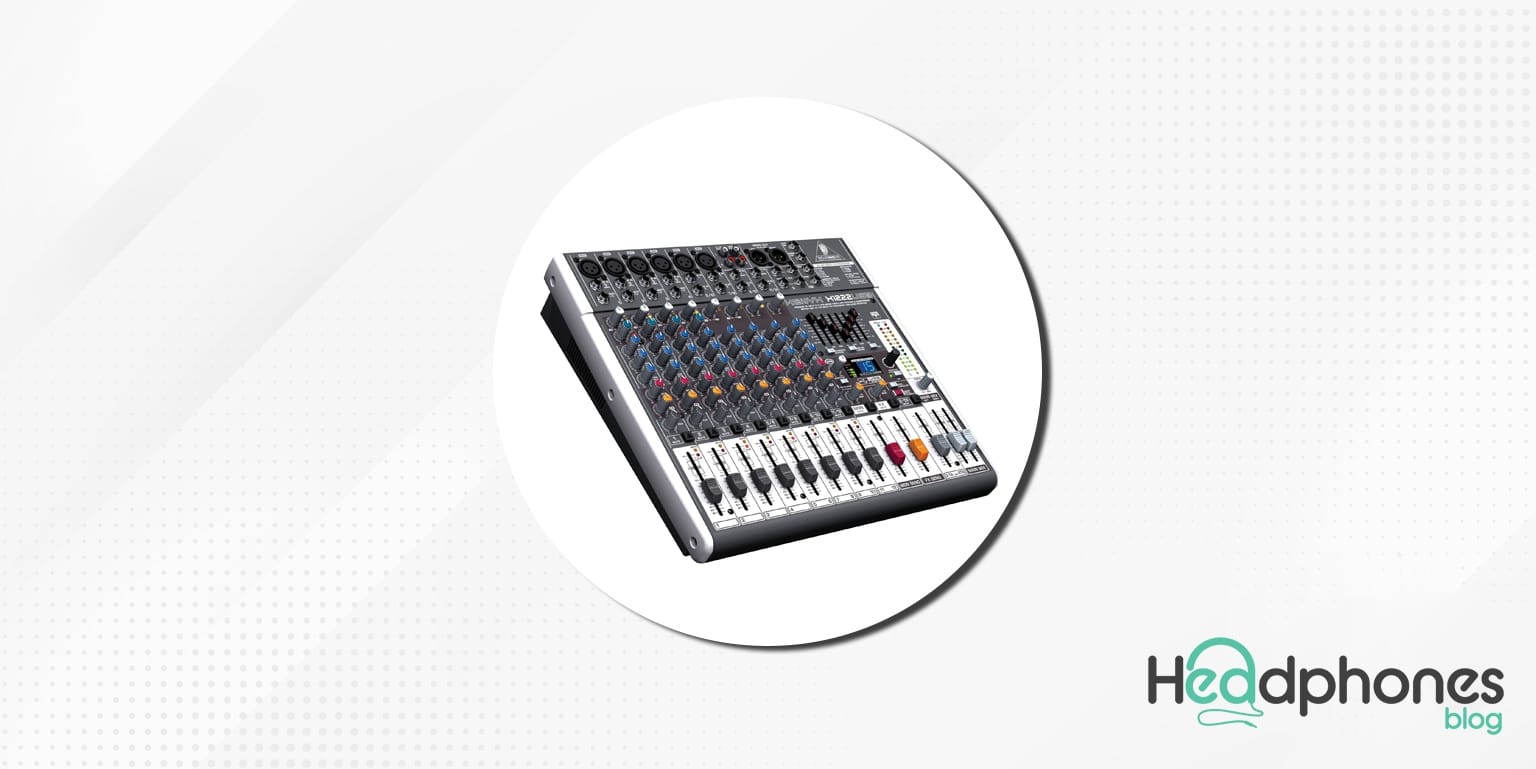
PRODUCT DESCRIPTION:
The Behringer X1222USB is small, but don’t be fooled by its size. It is powerful, portable, and large enough to meet your mixers for music needs. The Behringer X1222USB is a professional-grade analog mixer with four phantom-powered Xenyx mic preamps. In our tests, these preamps produced excellent results and could easily be compared to standalone boutique preamps. They also have a dynamic range of 130 dB.
This mixer also includes four professional compressors and LED control, allowing you to mix quickly and achieve the desired sound. The mixer has 16 presets, including reverb, flanger, chorus, delay, and other effects.
Can connect the XLR sources to two of the four available channels. In addition, Behringer has included an FBQ Feedback Detection System in this mixer, allowing you to achieve the desired sound without feedback. Furthermore, when the model detects feedback, the LED will light up, indicating which setting to change, which is a very useful feature.
With the included USB cable, you can easily connect it to any computer. The price of this model includes all software. For example, you could use the app’s 150+ virtual instruments to create your dream home studio.
ALL ABOUT THIS PRODUCT
- 12-channel USB Mixer with One-knob Compression.
- 3-b EQ Per Channel.
- 2 Aux Sends
PROS AND CONS
Here are some of the pros and cons of this product:
PROS
- Includes all of the software required for a fantastic audio mixing experience.
- There were no latency issues during the recordings.
- The design is compact and portable.
- Excellent for live performances.
CONS
- This audio mixer did not cause any problems for us.
SPECIFICATION
| Brand | Behringer |
| Number of Channels | 4 |
| Item Dimensions | 12.99 x 14.57 x 3.54 inches |
| Item Weight | 9.3 pounds |
| Connectivity Technology | USB |
9. Mackie Mix8 8-Channel Compact Mixer (Best Budget Audio Mixer)

PRODUCT DESCRIPTION:
The Mackie Mix8 8-Channel Compact Mixer has everything you need for great sound at a price that most artists and bands can afford. For example, it could be your primary sound system or secondary mixers for music surface for recording music to your computer. Furthermore, Mackie’s Mix8 offers high-quality audio at a low cost and is our choice for the best budget audio mixer on our list.
The Mackie Mix8 packs a powerful punch and is built to last despite its small size. The Mackie Mix8 has eight channels, two studio-quality mic/line inputs, phantom power for condenser microphones, and all channels have three-band EQ. It is suitable for small venues and produces high-quality sound for your events.
And, if that wasn’t enough, we could quickly change our vocal timbre by pressing a button! We were blown away by how simple it is to create professional-sounding mixers for music with this tiny mixer right out of the box. The Mix8 is rugged and lightweight, weighing only 8 pounds, thanks to its sturdy metal chassis and Mackie’s signature “made like a tank” architecture.
Furthermore, Mackie’s legendary preamps ensure that every input sounds clean and distortion-free, even at high volumes! However, there are some applications where it simply isn’t large enough.
ALL ABOUT THIS PRODUCT
- Compact 8-Channel Effects Mixer with Proven High-Headroom and Low-Noise Performance
- 2 mic/line inputs with studio-quality audio, pan, level, and overload indication, and phantom power for studio condenser microphones
- All channels have a 3-band EQ with clean, precise tone shaping.
- 1 additional send with stereo 1/4″ returns
PROS AND CONS
Here are some of the pros and cons of this product:
PROS
- It is possible to connect two microphones at the same time.
- Can use the three bands to fine-tune your sound.
- It has phantom power for studio condenser microphones.
- A good selection of mono and stereo inputs.
CONS
- It might not be suitable for use as a primary mixer.
- There aren’t enough channels for larger events.
SPECIFICATION
| Brand | Mackie |
| Number of Channels | 8 |
| Item Dimension | 9.6 x 7.8 x 2.1 inches |
| Item Weight | 2.5 pounds |
| Connectivity Technology | Auxiliary |
10. YAMAHA MG10XU 10-Input Stereo Mixer with Effects (Best Analog Audio Mixer)
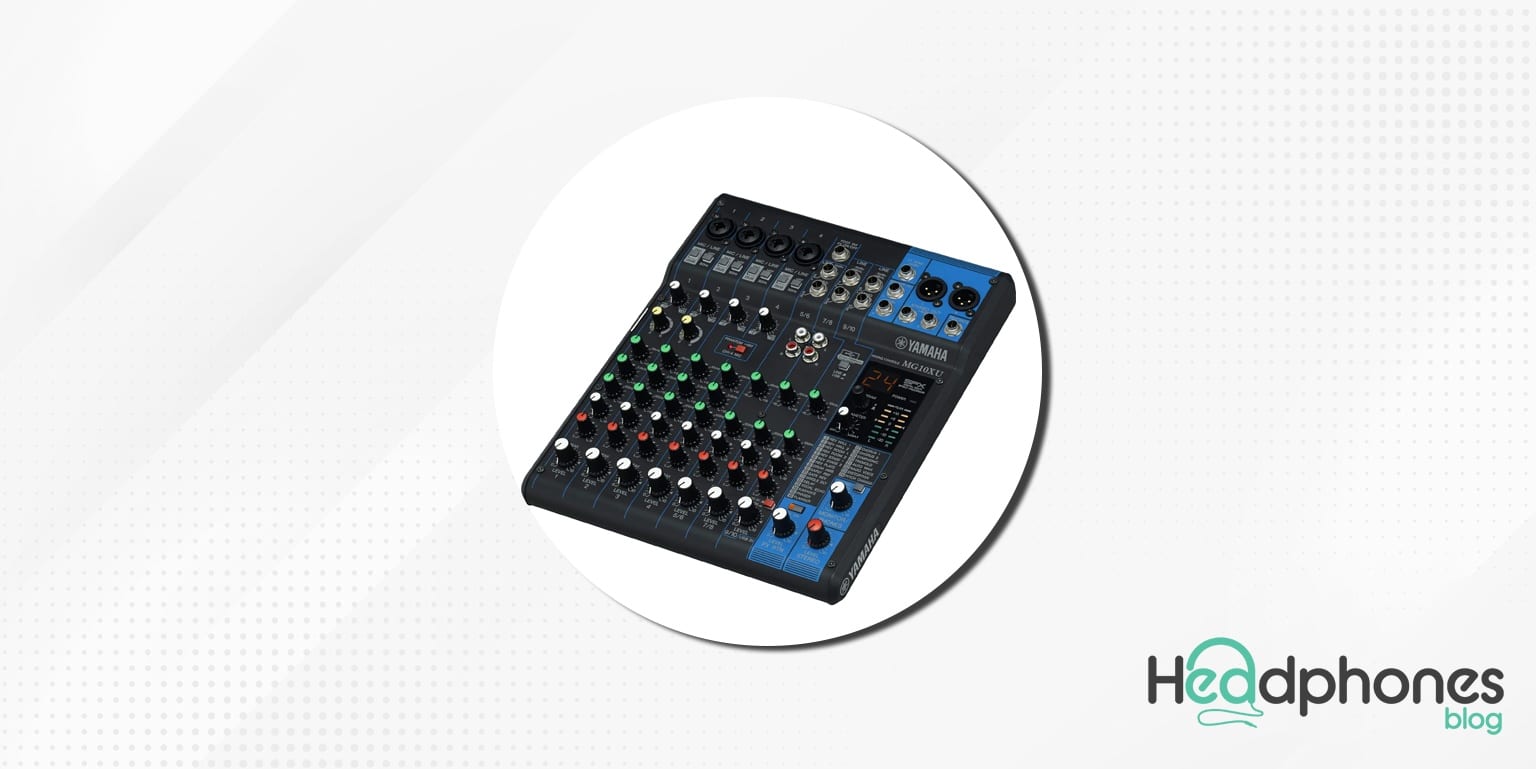
PRODUCT DESCRIPTION:
The Yamaha MG10XU is both a work of art and a functional piece of equipment. The controls are simple to use., and the build, quality, and presentation are all excellent. Yamaha’s best analog mixers for music on our list provide excellent sound quality and amazing effects.
The Yamaha MG10XU audio mixers for music is ideal for portable concerts and small home recording sessions. Furthermore, we were impressed by the MG10XU’s excellent audio quality and versatility. The integrated preamps provide the highest quality options for sparkling pure highs and unobstructed bass frequencies.
Four XLR lines, each with features, also function as 1/4′′ jacks. Two of them include compression control knobs and phantom power for condenser microphones. It has 24 digital effects that cover every sound you could want from a mixer for music. You can also listen to external audio through USB audio ports, cassette, CD, and RCA connections.
Furthermore, the interface setup, which includes a 3-band EQ and LED metering, is simple to learn and use. Yamaha is known for producing high-quality products, and the MG10XU is no exception. It’s also very small, making it easy to transport. It’s a great audio mixer for music
ALL ABOUT THIS PRODUCT
- 10-channel mixers for music with digital effects via USB and SPX.
- Studio-grade discrete class A D PRE amps with an inverted Darlington circuit deliver the fat, natural-sounding bass and smooth, soaring highs.
- The three-band EQ and high-pass filters give you complete control and eliminate unwanted noise, resulting in a cleaner mix.
- Compressors with one knob provide simple control, resulting in livelier guitars, punchier bass lines, tighter snares, and cleaner vocals.
- The MG Series mixers for music have a powder-coated metal chassis that is rugged and impact resistant; the equivalent input noise is 128 dBu, and the residual output noise is 102 dB.
PROS AND CONS
Here are some of the pros and cons of this product:
PROS
- 24 effects
- Lightweight and compact
- Highly suitable for karaoke and small studios
- Reliable and versatile
CONS
- Not suitable for large studios.
SPECIFICATION
| Brand | Yamaha |
| Number of Channels | 10 |
| Item Dimensions | 15.75 x 5.2 x 14.17 inches |
| Item Weight | 3390 Grams |
| Connectivity Technology | USB |
Things to Consider in Buying Audio Mixers
Here are some of the things that you need to consider when you’re buying a mixers for music.
EQ
A good audio mixers for music will have an EQ section. A simple three-band equalizer is usually sufficient.
However, in some cases, particularly when working with live bands and nuances to mix, having more detailed EQ options can be beneficial. A Graphic EQ, on the other hand, has a wider frequency range and will help you achieve the perfect tone across the board.
Effects
A good audio mixer should have some effects. When you add more effects, you usually end up with a more expensive system. Having digital effects at your disposal, on the other hand, can improve a mix.
Some singers prefer to use a reverb effect. The more options for sending to different channels you have, the better! Keyboardists might prefer to use a chorus effect on their channel. You should start cutting back on some extra features to save money.
If the effects are removed, it may be easier to find a cheaper mixer.
Portability
Portable mixers are required if you intend to transport them. Small mixers aren’t always the best option. Larger mixers for music can also be used on the road. Large shows frequently necessitate the transport of mixers between venues. You probably already know what you want if you’re looking for a large, portable mixer.
A smaller mixers for music is usually more portable and easier to move. Select a mixer with fewer than 16 channels if portability is important to you. Some mixers even have very delicate knobs and faders. Keep that in mind!
Functionality
The most sophisticated mixers for music isn’t always the best. Unless you know what features you require, it’s usually best to use something simple.
A user interface for a sound mixer should be simple and easy to use. Its simplicity will allow you to understand what is going on on the board and manipulate it as needed. To be the next Dr. Dre, you should dive into a more complicated interface and learn by doing.
Preamps
You should look for mixers for music with good microphone preamps. It’s one of the most important features to have if you want to control the quality of your audio. Filtering the sound is easier if a channel has a preamp because you don’t have to run your voice through a box capable of producing the desired tone.
Compatibility
Your mixer must be compatible with the software you’re using. When attempting to record or run a live show, you will encounter several issues if the software does not cooperate. It is critical to check compatibility with digital mixing DAWs when looking for a mixers for music. You must connect it to your computer via a USB interface. Your DAW may not function properly without a USB interface.
Frequently Asked Questions
Here are some of the frequently asked questions about audio mixers:
What are the requirements for sound mixer software?
However, the rise of the twenty-first century brings more options for simple and optimized audio mixing via sound mixer software. To enter this world on a budget, you only need a configured laptop, audio mixer software, and a control surface.
What characteristics distinguish a good mixer?
Some of the best mixers will have a simple interface to work. Simplicity is essential if you’re not a gearhead and only need a mixer to control basic audio functions. The easier it is to use, the faster you will understand what is going on on the board and how to manipulate it.
Can I get a mixer with a USB mic input?
The majority of professional mixers lack a USB interface or input. It is because USB microphone connections are generally less secure than XLR or 1/4″ jacks. USB microphones can be great for budget seekers who want to plug right into the computer, but audio mixers have a higher capability; however, some mixers include a USB interface.
What exactly is an audio mixer?
An audio mixer is any board into which you can connect your microphones or instruments and send them to an external speaker or recording source. Can use them to power live shows or studios to fine-tune the sound, so it plays properly on your MP3 player.
It is the tool you use to ensure that all of the volumes, tones, and effects work in unison in a balanced manner. Without an audio mixer, the sound would be completely off-balance, and no one would stay for the entire set.
Is it intended for beginners?
If so, investing in a live sound bundle would be wise. This bundle includes hardware, cables, and all electronic components. They have powered mixers as well as preset functions.
Are you an acoustic musician?
Then an analog audio mixer with knob and switcher control is the best option for you. It will allow you to make adjustments as you play. It also outperforms others in terms of performance.
Is it true that a mixer improves sound quality?
An audio mixer’s primary function is to blend mixed sounds and vary the bass, mids, and treble. This aids in producing better sounds from the sum of channel output. It means that a mixer not only optimizes sound but also filters it. It improves the sound quality of the output from the input.
How long can an audio mixer last?
Audio mixers typically have a life expectancy of 3-5 years. It is when they pay back the money invested in them. However, audio mixers that last more than 5 years are still relevant.
Conclusion
There are numerous excellent audio mixers available for everyday use. Every audio mixer is distinct from the others because each has its features. A key factor to consider when choosing the best audio mixer is your needs and the unit’s dependability for those needs.
You now have the information you need to make the best decision. Then you’re done. If you follow our buyer’s guide, you should have no problems. It is now time for you to enjoy the best audio mixer for you. For more details, check our website headphonesblog.com.

